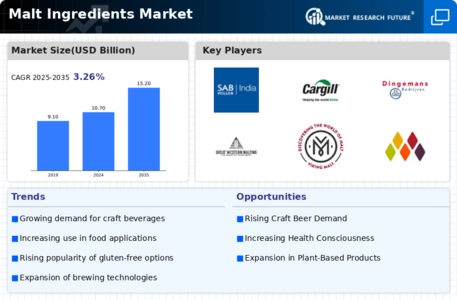Top Industry Leaders in the Malt Ingredients Market

Strategies Adopted by Malt Ingredients Key Players
The Malt Ingredients market, a crucial segment within the global food and beverage industry, is shaped by various factors such as the rising demand for malt-based products, the growing craft beer industry, and the versatile applications of malt in food processing. As of 2023, key players strategically position themselves in this competitive landscape, implementing various strategies to maintain or enhance their market share.
Key players in the Malt Ingredients market deploy a range of strategies to remain competitive. A central strategy involves continuous investment in research and development to innovate malt production processes and develop new malt-based products. Strategic collaborations with breweries, food manufacturers, and beverage companies contribute to expanding market reach, providing customized malt solutions for a variety of applications. Marketing efforts often focus on highlighting the quality, traceability, and sustainability of malt ingredients.
Market Share Analysis:
Market share analysis in the Malt Ingredients market is influenced by several factors, including brand recognition, product quality, pricing strategies, and distribution efficiency. Companies with strong brand equity and positive consumer perceptions tend to secure a larger market share. Pricing strategies that balance affordability with perceived value play a crucial role, especially considering the price sensitivity of consumers in this market. Effective distribution networks, covering both traditional and emerging channels, are vital for maintaining a competitive edge.
New and Emerging Companies:
While key players dominate the Malt Ingredients market, new and emerging companies are entering the sector, often focusing on specific niche markets or introducing innovative malt products. These entrants may emphasize specialty malts, organic or locally sourced malts, or cater to the growing demand for non-alcoholic malt beverages. Although their market share may be relatively modest compared to industry leaders, these companies contribute to the overall diversification and innovation in the Malt Ingredients market.
Industry Trends:
The Malt Ingredients market has witnessed noteworthy industry news and investment trends in 2023. Key players are investing in sustainable sourcing practices, emphasizing traceability and responsible supply chains to meet the growing demand for transparency. Collaborations with craft breweries and beverage companies are driving the development of customized malt blends to enhance flavor profiles. Additionally, investments in advanced malting technologies, such as precision malting and automation, aim to improve efficiency and reduce environmental impact in malt production.
Competitive Scenario:
The overall competitive scenario in the Malt Ingredients market is marked by intense rivalry among key players striving to capture a larger share of the growing market. The industry's competitiveness is evident in the emphasis on innovation, sustainability, and strategic collaborations to address evolving consumer preferences. The global reach of these companies enables them to adapt to regional tastes and capitalize on emerging markets, contributing to the overall dynamism of the industry.
Recent Development:
Cargill: To meet the rising demand for artisanal brews, the company collaborated with craft breweries to create specialised malts with distinctive flavour profiles and functions.Ingredient: Developed malted barley flour and malt syrup as useful ingredients for food producers, enhancing baked foods' sweetness, texture, and nutritional content.
Key Players:
Ociete Cooperative Agricole Axereal (France)Vivescia (France)Cargill Inc. (US)GrainCorp (Australia)Soufflet Group (France)Bairds Malt (UK)BARMALT MALTING INDIA PVT. LTD.(India)Briess Malt & Ingredients Co (US)COFCO (China)Country Malt Group (New York)Crisp Malting Group Limited (UK)Dalian Xingze Malt Processing Co.,Ltd. (China)EDME (UK)Muntons plc (England)Pure Malt Products Ltd (UK)Simpsons Malt Ltd (UK)


